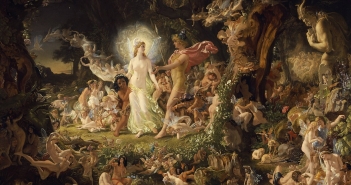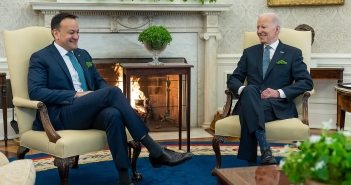Charles Baudelaire (1821–1867) reshaped the trajectory of modern literature. In acknowledgement T.S. Eliot famously called him ‘the Father of Modernism.’
Many monolingual English speakers might be unaware that, along with Shakespeare and Dante, Baudelaire has been instrumental to how we in the West perceive the world.
As an example, I think back to the early nineteen-nineties when I was living in Paris and the Austrian hosiery company Wolford were launching an advertising campaign using the photography of the celebrated fashion photographer Helmut Newton. I remember being on Place Concorde, not far from the Louvre, when his iconic black and white photographs of the giantesses were illuminated in the night sky, transforming the very street into a living interior of the exterior; just as Walter Benjamin had remarked about the arcades in his remarkable study of the nineteenth century French poet. This was pure Baudelaire in the late twentieth century.
Of course, the Baudelairean woman is a whole motif or trope in herself, and is certainly one of the principal reasons why readers, male and female, still turn to Baudelaire, as he is one of the few poets who can write about women and love in a truly remarkable way, and which still makes sense to us today.
Take the transversion of the poem ‘Sisina’ which I have transversed as ‘Wonder Woman’ in place of the name Théroigne, which according to my Flammarion notes is a reference to Théroigne de Mericourt (1762– 1817), who was involved in the French Revolution in 1792.
The poem makes reference to a particular incident which happened on a staircase. This same woman appears in the famous French historian Michelet’s Histoire de la Révolution Francais, and she is also found in the poet Lamartine’s Histoire des Girondins. Apparently, Baudelaire was inspired by a drawing by the artist Raffet that depicts the incident and which was published by Pommier & Pichois.
As this historical connection is likely to be lost on contemporary readers, I have supplanted it with the reference to the movie Wonder Woman. You have to choose your battles.
I was particularly impressed by the character in the film while watching it with my ten-year-old daughter, as I thought she made a very good role model for young girls. My choice, I believe, is in accord with the symbolism and underlining metaphor in the poem.
Baudelaire’s reference is to another actress Elisa Neri, who played the role of Théroigne, from what I understand, in theatrical productions during Baudelaire’s day. The poet came into contact with her through his attachment to Mme Sabatier, who was to have such an impact on him.
I am of course referencing the climax of the Marvel movie when Wonder Woman, played by Gal Gadot, confronts Ares the God of War – thus mirroring the original reference made by Baudelaire to Théroingne de Mericourt played by the actress Elisa Neri.
I expect Baudelaire would be entirely at home in today’s world where women have taken such a prominent place. After all, are the Gal Godot’s of today not the very same women of Baudelaire’s time? Women who showed incredible strength in the face of adversity.
Surely, it is in the role of the Amazonian that the Baudelairean Woman is most idealised, which the poem Sisina is an example of, though it certainly stands alone.
Spleen and Ideal is full of references to Amazonian and powerful women of which Lady Macbeth is one of the crowning figures, but first here is the poem ‘Sisina’ by Baudelaire followed by my transversion into English, which I have given the title ‘Wonder Woman’.
LIX.- SISINA
Imaginez Diane en galant equipage,
Parcourant les forêts ou battant les halliers,
Cheveux et gorge au vent, s’enivrant de tapage,
Superbe et defiant les meilleurs cavaliers!
Avez-vous vu Théroinge, amante du carnage,
Excitant à l’assaut un people sans souliers,
La joue et l’oeil en feu, jouant son personnage,
Et montant, sabre au pong, les royaux escaliers?
Telle la Sisina! Mais la douce guerrière
A l’àme charitable autant que meurtrière;
Son courage, affolé de poudre et de tambours,
Devant les suppliants sait metre bas les armes,
Et son Coeur, ravage par la flame, a toujours,
Pour qui s’en montre digne, un reservoir des larmes.
Wonder Woman
Imagine Diana and her gallant retinue
Charging through the forests bursting through the thickets,
Mane and throat to the wind, drunk on uproar,
Superbly defiant the best riders!
Have you seen Wonder Woman, lover of carnage,
Happily defending the down-trodden,
Cheek and eye aflame, enfevered in her role,
Assaulting, sword and shield in hand, the staircase?
Just like Gal Jadot! But the gentle warrior
Is as much a charitable soul as she is a seasoned killer;
Her courage, panicking in the explosions and drums,
Is to know when to put aside weapons before suppliants,
And her heart, ravaged by both fire and pain, is always,
For those who have some dignity, also a reservoir of tears.




